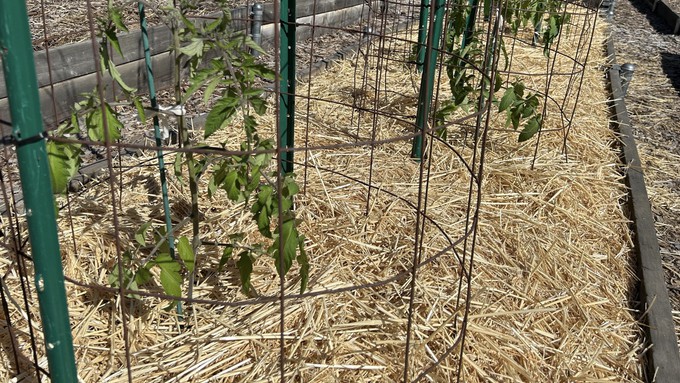
El Dorado County master gardeners offer free workshop with strategies for bountiful success

Tomato plants grow well in raised beds, a good solution for gardeners with less-than-ideal drainage or soil structure. Kathy Morrison
Poor drainage? Not enough room? Too much concrete?
Sometimes the best solution to creating a vegetable garden is to grow UP – plant those tomatoes and squash in raised beds and containers.
Summer vegetables and herbs grow very well in raised beds and many also will adapt to growing in pots, wine barrels or other containers. Learn tips for success during the in-person workshop, “Growing Veggies in Raised Beds & Other Containers.”
Set for 9 a.m. Saturday, June 29, this free three-hour class will be offered at Blackstone Community Center in El Dorado Hills. It’s open to the public; advance registration is encouraged. Find the registration link here: https://surveys.ucanr.edu/survey.cfm?surveynumber=42790.
UCCE Master Gardeners of El Dorado County will offer the best and most up-to-date advice about raised bed and contained gardening.
“Join Master Gardeners Mike Pavlick and Zack Dowell as they reveal the strategies for success with growing vegetables in raised beds and other containers,” say the organizers. “Mike will cover site location, raised bed and container options along with other methods that will allow anyone to grow veggies in a small backyard setting. Then, Zack will talk about how to grow vegetables including plant selection, planting times, soil preparation, seed planting techniques, fertilization and pest management.”
Blackstone Center is located at 1461 Blackstone Parkway, El Dorado Hills.
Questions? Email mgeldorado@ucanr.edu.
For more El Dorado County master gardener classes and events: https://mgeldorado.ucanr.edu/.
Comments
0 comments have been posted.Sacramento Digs Gardening to your inbox.
Food in My Back Yard Series
May 6: Maintain soil moisture with mulch for garden success
April 29: What's (already) wrong with my tomato plants?
April 22: Should you stock up on fertilizer? (Yes!)
April 15: Grow culinary herbs in containers
April 8: When to plant summer vegetables
April 1: Don't be fooled by these garden myths
March 25: Fertilizer tips: How to 'feed' your vegetables for healthy growth
March 18: Time to give vegetable seedlings some more space
March 11: Ways to win the fight against weeds
March 4: Potatoes from the garden
Feb. 25: Plant a fruit tree now -- for later
Feb. 18: How to squeeze more food into less space
Feb. 11: When to plant? Consider staggering your transplants
Feb. 4: Starting in seed starting
Sites We Like
Garden Checklist for week of May 4
Enjoy this spring weather – and get gardening!
* Plant, plant, plant! It’s prime planting season in the Sacramento area. Time to set out those tomato transplants along with peppers and eggplants. Pinch off any flowers on new transplants to make them concentrate on establishing roots instead of setting premature fruit.
* Direct-seed melons, cucumbers, summer squash, corn, radishes, pumpkins and annual herbs such as basil.
* Harvest cabbage, lettuce, peas and green onions.
* In the flower garden, direct-seed sunflowers, cosmos, salvia, zinnias, marigolds, celosia and asters. (You also can transplant seedlings for many of the same flowers.)
* Plant dahlia tubers. Other perennials to set out include verbena, coreopsis, coneflower and astilbe.
* Transplant petunias, marigolds and perennial flowers such as astilbe, columbine, coneflowers, coreopsis, dahlias, rudbeckia and verbena.
* Keep an eye out for slugs, snails, earwigs and aphids that want to dine on tender new growth.
* Feed summer bloomers with a balanced fertilizer.
* For continued bloom, cut off spent flowers on roses as well as other flowering plants.
* Add mulch to the garden to maintain moisture. Mulch also cuts down on weeds. But don’t let it mound around the stems or trunks of trees or shrubs. Leave about a 6-inch to 1-foot circle to avoid crown rot or other problems.